Sprawl is a novel that explores the limits and possibilities of language through a fragmented narrative of varying formats, utilizing experimental forms and dictionary-style entries.
 Pam Brown through her biography and quotes – celebrating her unique poetic voice and influential presence in Australian literature.
Pam Brown through her biography and quotes – celebrating her unique poetic voice and influential presence in Australian literature.
More about Pam Brown